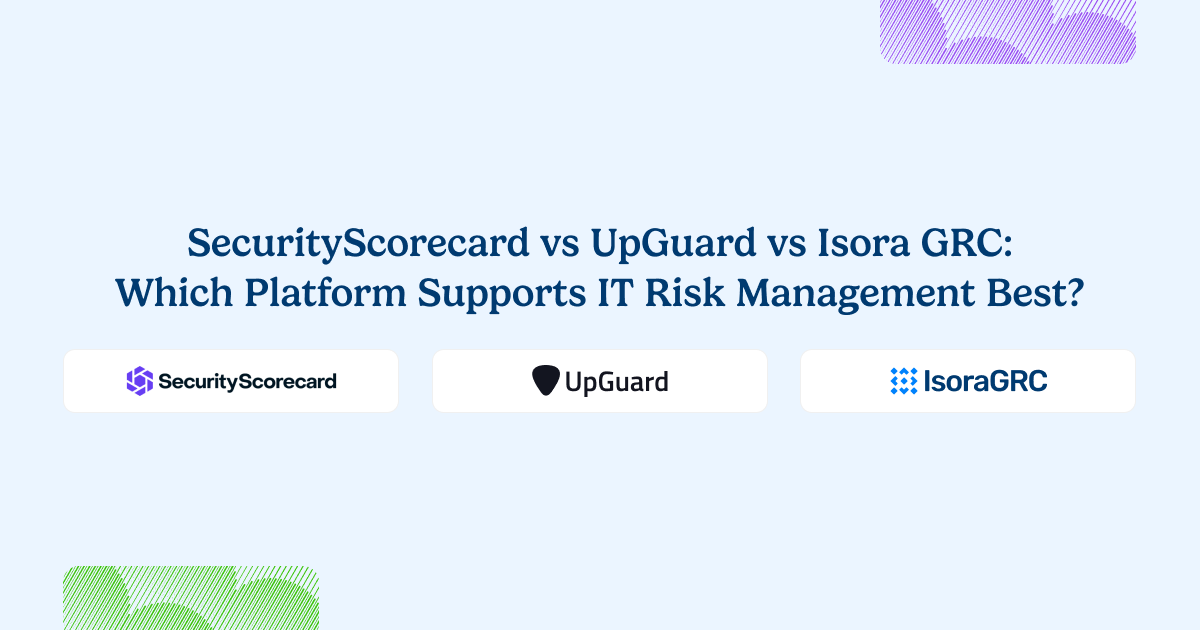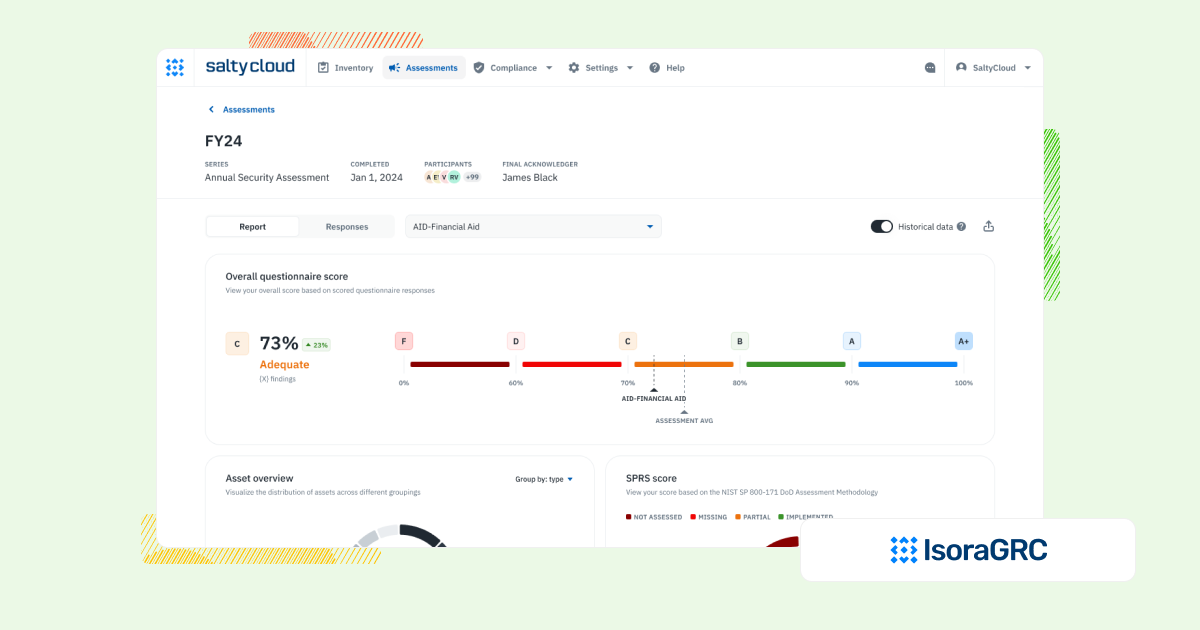
Every security team needs a comprehensive, scalable way to manage IT risk—not just monitor vendor scores.
Platforms like SecurityScorecard and UpGuard focus on vendor intelligence, offering external ratings to identify potential risks within your supply chain.
External scores can highlight issues, but they don’t help you assess, track, or resolve risks in a detailed, actionable way.
Isora GRC empowers teams with a better way to manage risk. It’s purpose-built for security teams who need to run assessments, manage inventories, and track risks, without relying solely on external ratings or static data.
Let’s analyze this more closely.
Choosing the Right Platform for IT Risk Management
SecurityScorecard and UpGuard deliver external security insights through automated scoring. But they’re not designed to manage vendor risk as a process. There are no workflows for assessing vendors with your own frameworks, collecting follow-up documentation, or engaging internal stakeholders in remediation.
Isora GRC is built for that exact use case. It lets you manage the full lifecycle: issuing assessments, tracking evidence, logging exceptions, scoring vendors against your criteria, and aligning findings with your risk register. It transforms vendor risk from a static score into a living system of accountability and action.
The Workflow That Matters: Managing IT Risks and Compliance
Third-party risk workflows demand structure. Security teams need to issue assessments, follow up on red flags, track issues to resolution, and report on outcomes across vendors and cycles. That level of structure isn’t possible with rating platforms alone.
Isora GRC enables teams to run assessments in cycles, reuse templates, assign issues, and maintain centralized oversight. It supports multiple frameworks and ensures that no vendor slips through the cracks. Risk becomes not just visible—but actively managed.
How Each Platform Supports IT Risk Management Workflows
| Workflow Area | SecurityScorecard | UpGuard | Isora GRC |
| Assessment Management | SecurityScorecard focuses on rating and checking outside companies for security risks. This helps with vendor risk but doesn’t go deep enough for full internal assessments. Teams needing risk checks across many departments might want more control and flexibility. | UpGuard offers strong tools for assessments, security ratings, and leak detection. Still, some users say it takes time to learn the platform. | Centralized, intuitive assessment dashboard across business units, vendors, and assets. Built specifically for security teams. |
| Questionnaire Delivery & Completion | SecurityScorecard doesn’t focus on sending surveys or forms. It mainly runs automatic checks on third-party risks. This may not work well for teams needing custom surveys or forms for internal use. | The system handles questionnaires well. But users wanting deep customization might feel limited. | Customizable and prebuilt questionnaires for frameworks like NIST, ISO, GLBA, HIPAA, and more. Designed for internal and external collaboration. |
| Inventory Tracking | SecurityScorecard skips full inventory tools. It works mostly on security ratings for outside vendors. Companies with large internal systems or many assets might find this missing feature a problem. | UpGuard checks vendors and their security levels. Still, full asset tracking is not the main focus. | Centralized tracking of assets, vendors, and organizational units with integration support for existing data sources. |
| Risk Register & Exception Management | SecurityScorecard gives insight into third-party risks but lacks full risk register tools and detailed exception handling. Companies needing full internal tracking for risks and exceptions might feel limited. | Risk tools exist, but advanced features may need expert help. Less technical users could struggle. | Flexible, collaborative risk register with scoring, status, evidence, and ownership tied directly to assessments. Exception management is built-in and intuitive—no extra modules or configuration required. |
| Scoring, Reporting & Risk Visualization | SecurityScorecard does well with external security ratings and reports. But those needing deep reports and charts for internal risks might find the platform too narrow. Reports focus on outside risks, not full internal tracking. | UpGuard includes security scores and reports. However, risk visuals may feel basic to some users. | Automated scorecards, risk maps, and executive-friendly reports with actionable insights—no manual config required. |
| Collaboration & User Experience | The design is clean and works well for security teams checking outside risks. But tools for teamwork may feel weak compared to platforms built for broader tasks. Internal risk teams might miss features for better group work. | The platform works well for tech users. But learning to use the collaboration tools may take time. | WCAG-compliant, award-nominated interface with built-in commenting, team workflows, and fast onboarding. |
| Implementation & Setup | Setup is simple for companies focused on vendor risks. But those needing a full GRC system for internal work may need extra tools. The system fits outside risk checks best, with limited links to internal processes. | UpGuard needs time and resources to set up. Teams may need training and support for smooth use. | No-code setup in days or weeks. Minimal IT lift required. Designed to go live quickly across teams and vendors. |
What Sets Isora GRC Apart?

Isora GRC was purpose-built for information security teams—designed to support the real workflows behind risk and compliance, not just generate reports. While legacy GRC platforms require months of configuration and rigid processes, Isora takes a modern, scalable approach:
- Purpose-built for security and third-party risk teams
- No extra modules or cross-department bloat—just the workflows that matter.
- Easy for anyone to use
- Clean UI, no complex training, and built to drive adoption across the org.
- Streamlined for action, not just documentation
- Assessments, questionnaires, inventories, risk tracking, and reporting—all in one place.
- Fast, no-code implementation
- Go live in weeks, not quarters, with minimal IT lift.
- Scales with your program
- Whether you’re running a lean risk function or supporting a large institution, Isora grows with you—without getting in the way.
Who Each Platform Is Best For
| Platform | Who It’s For |
| SecurityScorecard | Seeing how vendors stack up at a glance. Doesn’t help much with full program management. |
| UpGuard | Getting a quick view of vendor security from the outside. Helpful info, but not a full-risk solution. |
| Isora GRC | Security teams that need a scalable, usable IT risk management program across their organization. |
What Our Customers Say About Isora GRC
Security teams at top institutions are using Isora GRC to replace legacy tools and manual processes with intuitive workflows and actionable insight.
“Moving from manual processes to using Isora was a breath of fresh air. What used to take months is now automated, reliable, and defensible. Isora saves us significant time while delivering accurate insights that improve decision-making.”
Jessica Sandy, IT GRC Manager, The University of Chicago
“Isora has been essential in helping us meet our University of California cybersecurity requirements across a decentralized campus. Automating assessment data collection and reporting has given us clear visibility into unit-level risks, enabling us to prioritize resources effectively and address gaps with confidence.”
Allison Henry, CISO, The University of California, Berkeley
FAQs
What’s the difference between SecurityScorecard, UpGuard, and Isora GRC?
SecurityScorecard and UpGuard provide external security ratings and monitoring based on publicly available data. Isora GRC supports hands-on third-party risk workflows—like issuing questionnaires, managing vendor inventories, tracking exceptions, and maintaining a risk register—so teams can actively assess and manage risk.
Are SecurityScorecard and UpGuard considered vendor risk management platforms?
They’re best described as vendor intelligence tools. While they provide external signals, they don’t support the full lifecycle of third-party risk management—such as collecting documentation, assigning follow-ups, or engaging vendors directly.
Does Isora GRC replace tools like SecurityScorecard or UpGuard?
Yes, for teams that want to go beyond passive monitoring. Isora GRC enables vendor assessments using frameworks like HECVAT, CAIQ, and SIG, supports exception tracking, and centralizes third-party risk data for real-time visibility and action.
Which platform is better for managing vendor risk across the organization?
Isora GRC is built specifically for that purpose. While SecurityScorecard and UpGuard provide valuable insights, Isora supports the actual workflows required to manage vendor risk—from assessments to remediation and reporting.
Can Isora GRC be used alongside SecurityScorecard or UpGuard?
Yes. Some organizations use external scoring tools to supplement their risk picture, while relying on Isora GRC for internal workflows, vendor communications, and assessment tracking.
What should I look for in a third-party risk management platform?
Look for support for custom and standardized assessments, vendor collaboration, inventory tracking, and exception management. Isora GRC enables these workflows in a single platform security teams can fully own.



















 Other Relevant Content
Other Relevant Content